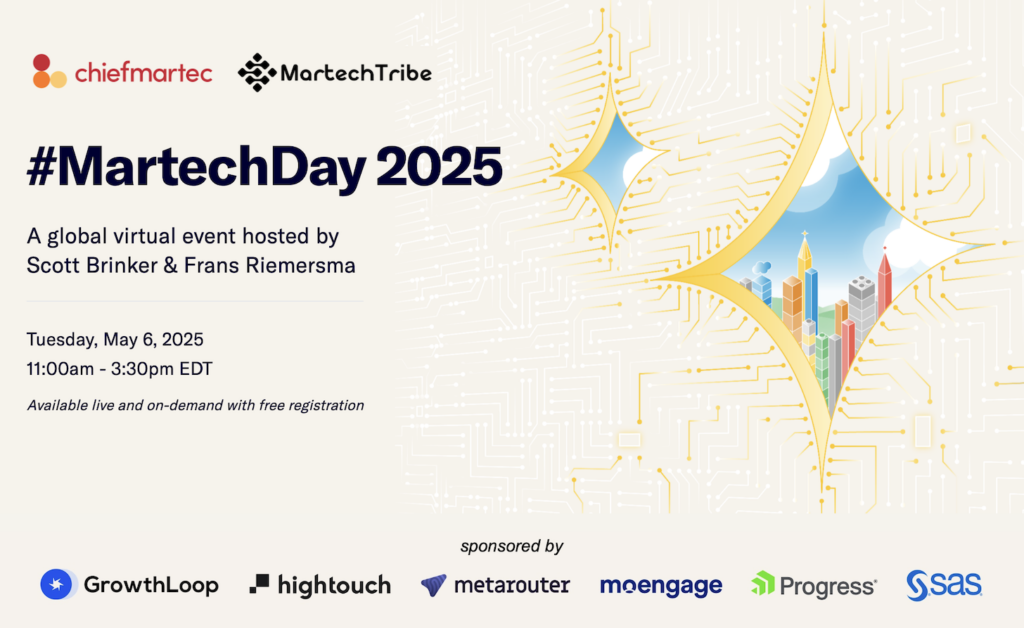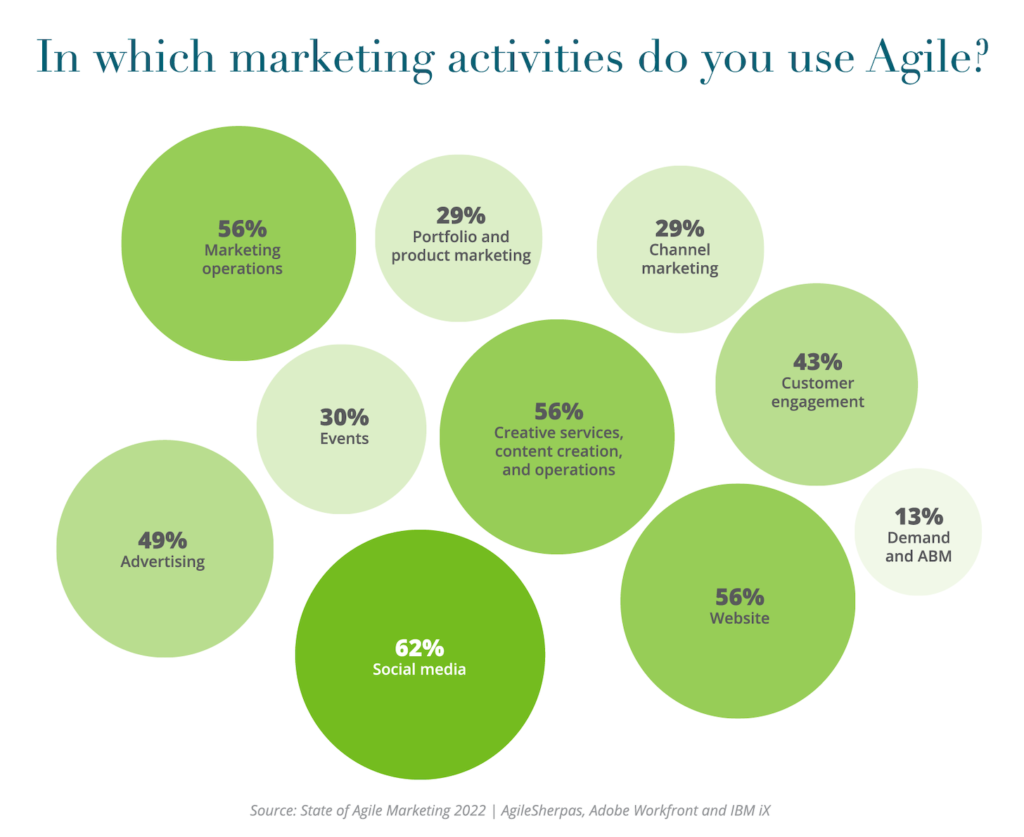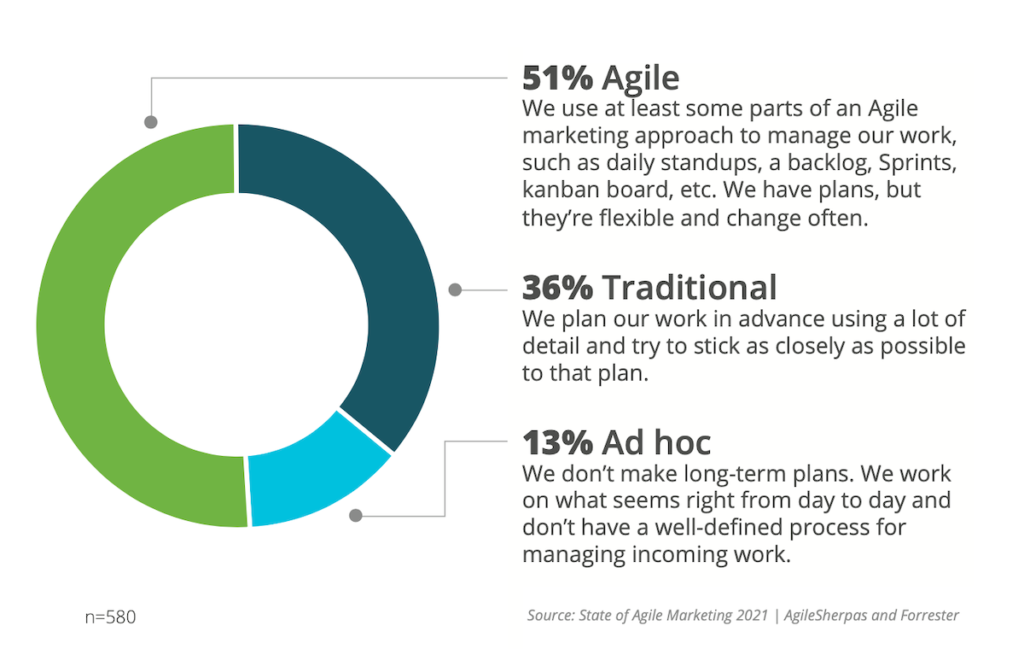The following is a short excerpt from The State of Martech 2025 report that will be published on May 6, 2025 — #MartechDay. Sign up for free to attend our keynote presentation, which you can watch live or on-demand. You’ll also get first access to our 100+ page report, the new 2025 marketing technology landscape, and full deck of all the 2025 Stackie Award entries.
Don’t miss the martech bundle of the year — register now.
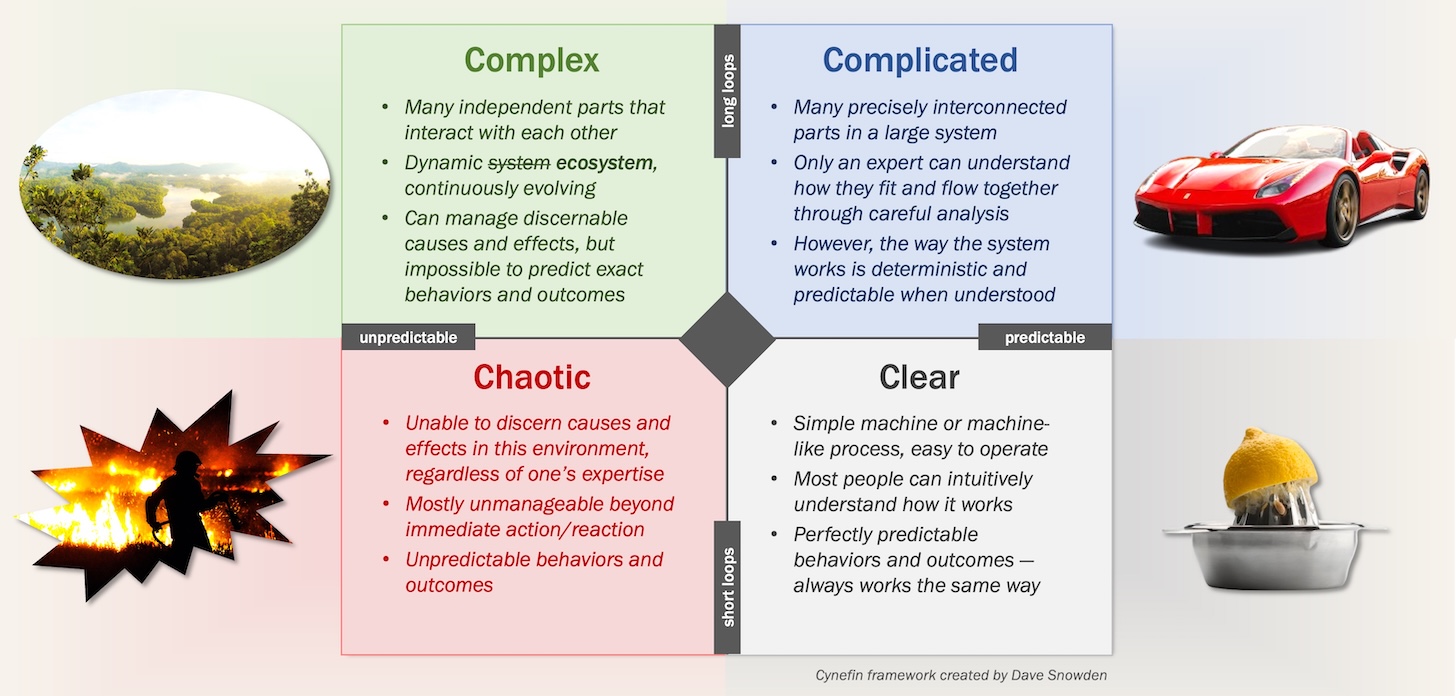
Martech is going from being complicated to being complex.
Those two words sound like synonyms. But here we mean them as technical concepts that are fundamentally different from each other. To explain this distinction and what it means for the future of marketing operations, we want to use the Cynefin framework.
Created by Dave Snowden in 1999, the Cynefin framework describes four different kinds of environments in which sense-making occurs — clear, complicated, complex, and chaotic — in a 2×2 matrix.
Starting from the lower right, a “clear” sense-making environment is where cause and effect are directly and obviously linked. Do x and y will happen. It’s almost a perfectly predictable machine. Anyone can intuitively understand how it works.
We used a picture of a manual juice squeezer as a visual metaphor. Take half a citrus fruit, squeeze and twist it on the juicer, get juice. Not a lot of debugging or advanced analytics required. In marketing, an example might be a simple, fixed automation such as sending a standard “welcome” email to someone who signs up for your newsletter.
Moving to the upper right, we enter the “complicated” space. In a complicated environment, there are now many moving parts, intricately interconnected. Things still work deterministically, but they follow a much more windy path. Instead of do x and y will happen, it’s more like: do a and then x, y, or z will happen depending on steps and branches between a-z. Only an expert who really understands the architecture of a complicated system can comprehend the intricate decision logic between cause and effect. To a non-expert, the outcome may seem random. But it’s not.
The visual metaphor we chose here is a Ferrari. It is a precision-crafted machine with many interconnected pieces. They do work together in a predictable fashion. However, while it’s fairly easy to get behind the wheel and drive one, if something breaks and the car stops running, it may not be so easy to figure out why. You will likely need a trained and experienced Ferrari mechanic to diagnose and repair it.
In marketing, we think the martech stack as a whole — at least how it’s been structured and operated to date — is a quintessential example of a complicated system. The logic for how your stack works is deterministic, a function of how all of the different platforms and apps within it have been programmed, configured, and integrated. But because the overall system is so large and has so many interconnected parts, it can be difficult for a non-expert to understand why it behaves certain ways. You really need a trained and experienced marketing ops professional.
Now things get interesting when we move to the upper left, from complicated to “complex.” In a complex environment, there are also many, many different and interrelated parts. But they have greater independence, and the way they interact is more dynamic and probabilistic. To be sure, there is still cause and effect. But it’s impossible to perfectly predict a specific cause resulting in a specific effect.
Our visual metaphor here is a rainforest. It’s an ecosystem of many different flora and fauna that interact with each other in all sorts of fascinating ways. Causes beget effects, which serve as causes for other effects, which cause other things… and so on in the great circle of life.
People can definitely impact a rainforest — sadly, usually not for the better. But we can also be stewards of the ecosystem and engage, at least directionally, with causes and effects in context. For instance, if you pull a sleeping tiger’s tail, we can’t guarantee precisely what will happen next. But odds are it’s not going to be pleasant.

In marketing, the introduction of LLMs and increasingly autonomous AI agents makes martech complex in this way. The outputs of LLMs are, for all practical purposes, probabilistic. The same prompt will not give you the same answer every time. It may give you something similar. But that’s not the same. If those outputs are used to make decisions or trigger outcomes, then the chain of what happens next is also probabilistic, even if specific steps within the chain follow more deterministic if-x-then-y rules.
Most AI agents rely on these LLMs and their reasoning engines to power their autonomous decisions and actions. They become more independent. They increasingly have the ability to interact with each other, through protocols like MCP and A2A. And the number of different agents — small and large, stand-alone and embedded, commercial and custom — operating in stacks is growing.
The resulting martech stack becomes more like a rainforest than a Ferrari.
It is an ecosystem more than a machine.
This is not inherently a bad thing! In fact, a rainforest-like stack can be much more adaptable, powerful, and scalable. It can evolve more organically. But it does require marketing operations to evolve beyond building and maintaining piles and piles of rigid, linear processes:
- Embrace a more modular, loosely-coupled architecture for the stack, favoring open and interoperable apps and platforms — i.e., composable martech
- Enhance mechanism of “observability” — streaming logs, dashboards, and anomaly alerts to identify when probabilistic outcomes are drifting out of expected boundaries
- Engage in more safe-to-fail experiments, where new AI agents and agentic capabilities are tested in small, limited pilots to learn how they (probabilistically) behave
- Institute human-in-the-loop checkpoints for larger decisions, such as audience selection or budget allocation to guard against biased or runaway behaviors — trust but verify
- Build cross-functional “sense-maker” pods of small, empowered teams that include marketing ops, data engineering, AI/ML, and compliance to evaluate and interpret emergent behaviors and make adjustments on-the-fly
- Invest in greater data maturity, especially with your underlying data infrastructure and data pipelines to validate incoming data quality, label drift, and output coherence
- Promote a culture of experimentation: reward teams for uncovering unexpected failure modes or novel wins, not just “hitting targets”
To finish up our explanation of the Cynefin framework, the fourth sense-making environment, in the lower left corner, is “chaotic.” This is where there’s simply no time to methodically consider all possible causes and effects or how they interrelate. Instead, with limited information and a ticking clock, you have to take action quickly, as best you can. The outcome is not predictable. But hopefully with the right heuristic, you’ll do alright.
The visual metaphor here is a building on fire. Head for the exit as quickly as you can. Save the detailed analysis for the fire marshal investigating it later.
In marketing, you could say that a completely unmanaged martech stack, with many chefs in the kitchen and near zero governance, is essentially a chaotic environment.
It’s important to emphasize that a complex environment is not an unmanaged environment. It’s just more probabilistic than we’ve been used to with martech these past couple of decades.
We still want and need to orchestrate experiences for employees and customers in a complex stack. But instead of a single master “orchestrator” in the stack, we’re likely to see multiple tools — apps, agents, platforms — that orchestrate different contextual experiences for those users.
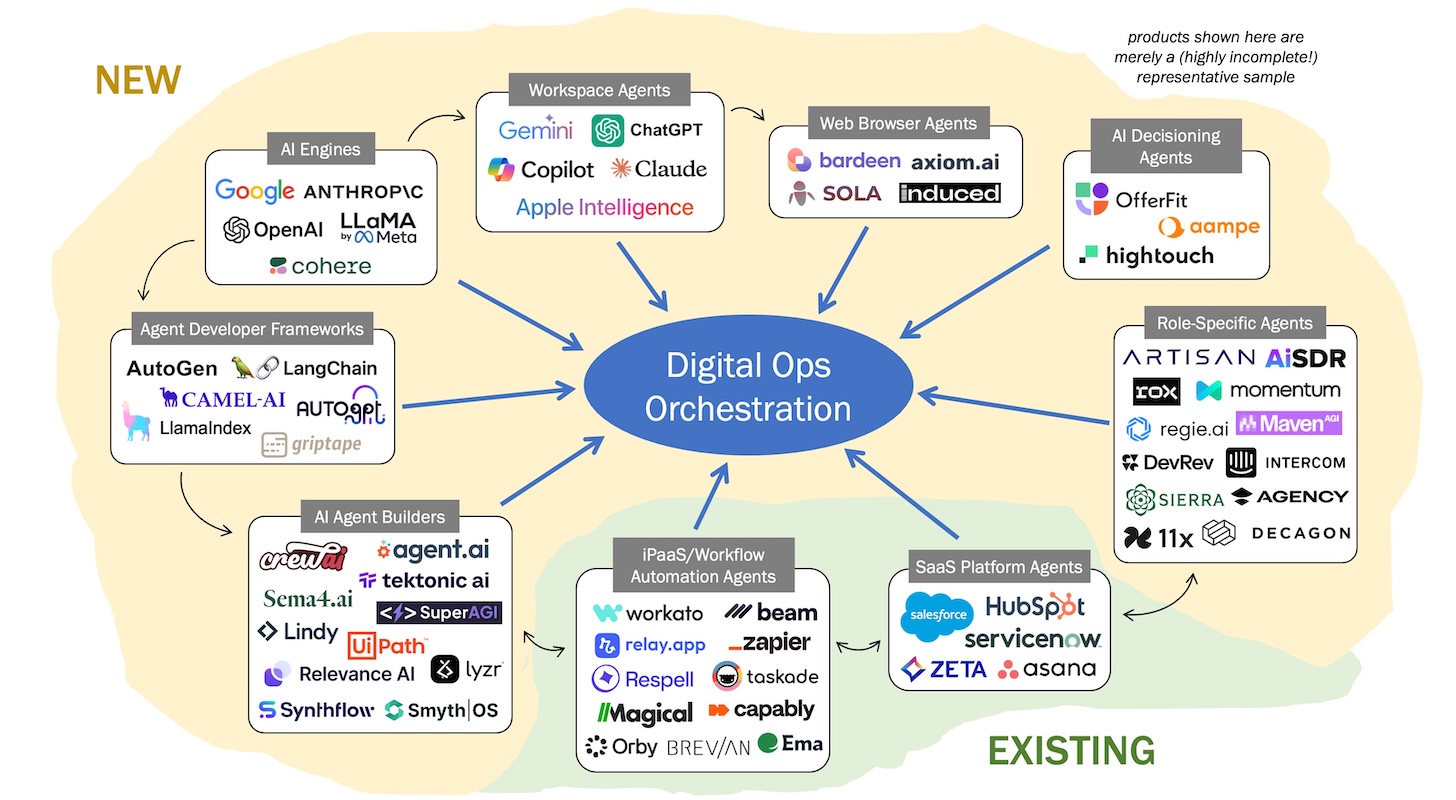
For a while, we were converging towards large SaaS marketing platforms and leading iPaaS and workflow automation platforms being the two kinds of orchestrators. Those platforms are still a big part of the martech stack and will certainly be major orchestrators of AI agents.
But there are now many new categories of AI agents coming on the scene. The big AI assistants-turned-agents such as ChatGPT, Claude, and Gemini. Role-specific agents such as 11x, Rox, and Sierra. AI agent builders such as CrewAI and agent.ai. Web browser-based agents such as Bardeen, Induced, and Sola. And plenty of frameworks, such as LangChain, Camel.ai, and AutoGPT for software developers to build their own agents.
Things are going to be more complex. Again, that’s not necessarily bad. But it is different.
It’s more like a jazz improvisation than a precisely scored Bach concerto. Actually, more like a multitude of improvising jazz trios playing in parallel across the organization, rather than one full symphony orchestra with a single maestro conductor.
This is the era of Big Ops — managing a spectacular volume, variety, and velocity of apps, agents, and automations, all simultaneously operating and interacting across the organization.
It’s also why the future of marketing operations and martech management is bright.
Don’t forget to sign up for #MartechDay to get the full 100+ page report this post was excerpted from and catch our keynote discussion live or on-demand. See you there!
